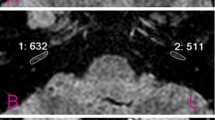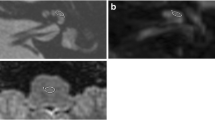Abstract
Purpose
Our study investigated correlations between clinical characteristics, particularly hearing recovery, interval time between onset and three-dimensional fluid attenuation inversion recovery magnetic resonance imaging (3D-FLAIR MRI), and the signal intensity of post-contrast 3D-FLAIR MRI in patients with idiopathic sudden sensorineural hearing loss (SSNHL).
Methods
The study enrolled 100 SSNHL patients. The signal intensities and asymmetry ratios of the inner ear structures, including the cochleae, vestibules and vestibulocochlear nerve, were evaluated and calculated. The relationships between the clinical characteristics and MRI findings were assessed.
Results
After intravenous gadolinium (Gd) injection, 3D-FLAIR revealed high signal intensities in 65 patients. The corrected asymmetry ratios of cochlea correlated closely with interval time between onset and MRI. The asymmetry ratios of the inner ear structures were significantly lower in patients with final complete to partial hearing recovery. The corrected asymmetry ratios of the inner ear structures correlated with initial/final pure tone audiometry (PTA) and hearing recovery in the affected ear. Notably, it was shown that the corrected asymmetry ratios identified a poor prognosis for hearing recovery, with a sensitivity and specificity of 67.9% and 75.0% in the cochlea, 83.3% and 75.0% in the vestibule, and 52.4% and 81.2% in the vestibulocochlear nerve, respectively.
Conclusions
Post-contrast 3D-FLAIR after intravenous Gd injection in SSNHL can be used to assess the permeability of the blood–labyrinth and blood–nerve barriers. The asymmetry ratios of the inner ear structures may identify patients with poor prognosis for hearing recovery. Signal characteristics are closely related to interval time between onset and MRI.



Similar content being viewed by others
References
Berrettini S, Seccia V, Fortunato S, Forli F, Bruschini L, Piaggi P, Canapicchi R (2013) Analysis of the 3-dimensional fluid-attenuated inversion-recovery (3D-FLAIR) sequence in idiopathic sudden sensorineural hearing loss. JAMA Otolaryngol Head Neck Surg 139(5):456–464. https://doi.org/10.1001/jamaoto.2013.2659
Biavati MJ, Gross JD, Wilson WR, Dina TS (1994) Magnetic resonance imaging evidence of a focal pontine ischemia in sudden hearing loss and seventh nerve paralysis. Am J Otol 15(2):250–253
Chau JK, Lin JR, Atashband S, Irvine RA, Westerberg BD (2010) Systematic review of the evidence for the etiology of adult sudden sensorineural hearing loss. Laryngoscope 120(5):1011–1021. https://doi.org/10.1002/lary.20873
Eisenman D, Arts HA (2000) Effectiveness of treatment for sudden sensorineural hearing loss. Arch Otolaryngol Head Neck Surg 126(9):1161–1164
Gao Z, Chi FL (2014) The clinical value of three-dimensional fluid-attenuated inversion recovery magnetic resonance imaging in patients with idiopathic sudden sensorineural hearing loss: a meta-analysis. Otol Neurotol 35(10):1730–1735. https://doi.org/10.1097/MAO.0000000000000611
Hajnal JV, Bryant DJ, Kasuboski L, Pattany PM, De Coene B, Lewis PD, Pennock JM, Oatridge A, Young IR, Bydder GM (1992) Use of fluid attenuated inversion recovery (FLAIR) pulse sequences in MRI of the brain. J Comput Assist Tomogr 16(6):841–844
Huang LQ, Whitworth JA, Chesterman CN (1995) Effects of cyclosporin A and dexamethasone on haemostatic and vasoactive functions of vascular endothelial cells. Blood Coagul Fibrinolysis 6(5):438–445
Hughes GB, Freedman MA, Haberkamp TJ, Guay ME (1996) Sudden sensorineural hearing loss. Otolaryngol Clin N Am 29(3):393–405
Jack CJ, Rydberg CH, Krecke KN, Trenerry MR, Parisi JE, Rydberg JN, Cascino GD, Riederer SJ (1996) Mesial temporal sclerosis: diagnosis with fluid-attenuated inversion-recovery versus spin-echo. MR imaging Radiol 199(2):367–373. https://doi.org/10.1148/radiology.199.2.8668780
Jin EH, Liang YT, Ma DQ (1999) Diagnostic evaluation of subacute and chronic subarachnoid hemorrhage with MRI using turbo fluid attenuated inversion recovery pulse sequence. Chin J Radiol(6):384. https://doi.org/10.3760/j.issn:1005-1201.1999.06.008
Kim C, Sohn JH, Choi HC (2012) Vertebrobasilar angulation and its association with sudden sensorineural hearing loss. Med Hypotheses 79(2):202–203. https://doi.org/10.1016/j.mehy.2012.04.035
Kim TY, Park DW, Lee YJ, Lee JY, Lee SH, Chung JH, Lee S (2015) Comparison of inner ear contrast enhancement among patients with unilateral inner ear symptoms in MR images obtained 10 minutes and 4 hours after gadolinium injection. AJNR Am J Neuroradiol 36(12):2367–2372. https://doi.org/10.3174/ajnr.A4439
Lee HY, Jung SY, Park MS, Yeo SG, Lee SY, Lee SK (2012) Feasibility of three-dimensional fluid-attenuated inversion recovery magnetic resonance imaging as a prognostic factor in patients with sudden hearing loss. Eur Arch Otorhinolaryngol 269(8):1885–1891. https://doi.org/10.1007/s00405-011-1834-1
Liao WH, Wu HM, Wu HY, Tu TY, Shiao AS, Castillo M, Hung SC (2016) Revisiting the relationship of three-dimensional fluid attenuation inversion recovery imaging and hearing outcomes in adults with idiopathic unilateral sudden sensorineural hearing loss. Eur J Radiol 85(12):2188–2194. https://doi.org/10.1016/j.ejrad.2016.10.005
Loughran S (2000) Management of sudden sensorineural hearing loss: a consultant survey. J Laryngol Otol 114(11):837–839
Moayer R, Ishiyama GP, Karnezis S, Sepahdari AR, Ishiyama A (2018) High resolution three-dimensional delayed contrast MRI detects endolymphatic hydrops in patients with vertigo and vestibular schwannoma. Otol Neurotol 39(1):e39–e44. https://doi.org/10.1097/MAO.0000000000001627
Morange PE, Aubert J, Peiretti F, Lijnen HR, Vague P, Verdier M, Negrel R, Juhan-Vague I, Alessi MC (1999) Glucocorticoids and insulin promote plasminogen activator inhibitor 1 production by human adipose tissue. Diabetes 48(4):890–895
Naganawa S, Koshikawa T, Nakamura T, Kawai H, Fukatsu H, Ishigaki T, Komada T, Maruyama K, Takizawa O (2004) Comparison of flow artifacts between 2D-FLAIR and 3D-FLAIR sequences at 3 T. Eur Radiol 14(10):1901–1908. https://doi.org/10.1007/s00330-004-2372-7
Rydberg JN, Hammond CA, Grimm RC, Erickson BJ, Jack CJ, Huston JR, Riederer SJ (1994) Initial clinical experience in MR imaging of the brain with a fast fluid-attenuated inversion-recovery pulse sequence. Radiology 193(1):173–180. https://doi.org/10.1148/radiology.193.1.8090888
Ryu IS, Yoon TH, Ahn JH, Kang WS, Choi BS, Lee JH, Shim MJ (2011) Three-dimensional fluid-attenuated inversion recovery magnetic resonance imaging in sudden sensorineural hearing loss: correlations with audiologic and vestibular testing. Otol Neurotol 32(8):1205–1209. https://doi.org/10.1097/MAO.0b013e31822e969f
Sugiura M, Naganawa S, Teranishi M, Nakashima T (2006) Three-dimensional fluid-attenuated inversion recovery magnetic resonance imaging findings in patients with sudden hearing loss. Laryngoscope 116(8):1451–1454. https://doi.org/10.1097/01.mlg.0000228005.78187.23
Tagaya M, Teranishi M, Naganawa S, Iwata T, Yoshida T, Otake H, Nakata S, Sone M, Nakashima T (2010) 3 T magnetic resonance imaging obtained 4 hours after intravenous gadolinium injection in patients with sudden deafness. Acta Otolaryngol 130(6):665–669. https://doi.org/10.3109/00016480903384176
Tanigawa T, Shibata R, Tanaka H, Gosho M, Katahira N, Horibe Y, Nakao Y, Ueda H (2015) Usefulness of three-dimensional fluid-attenuated inversion recovery magnetic resonance imaging to detect inner-ear abnormalities in patients with sudden sensorineural hearing loss. J Laryngol Otol 129(1):11–15. https://doi.org/10.1017/S0022215114003028
Tanigawa T, Tanaka H, Sato T, Nakao Y, Katahira N, Tsuchiya Y, Nonoyama H, Ueda H (2010) 3D-FLAIR MRI findings in patients with low-tone sudden deafness. Acta Otolaryngol 130(12):1324–1328. https://doi.org/10.3109/00016489.2010.496461
Whitaker S (1980) Idiopathic sudden hearing loss. Am J Otol 1(3):180–183
Wilson WR, Byl FM, Laird N (1980) The efficacy of steroids in the treatment of idiopathic sudden hearing loss. A double-blind clinical study. Arch Otolaryngol 106(12):772–776
Yoshida T, Sugiura M, Naganawa S, Teranishi M, Nakata S, Nakashima T (2008) Three-dimensional fluid-attenuated inversion recovery magnetic resonance imaging findings and prognosis in sudden sensorineural hearing loss. Laryngoscope 118(8):1433–1437. https://doi.org/10.1097/MLG.0b013e318172ef85
Zivadinov R, Ramasamy DP, Hagemeier J, Kolb C, Bergsland N, Schweser F, Dwyer MG, Weinstock-Guttman B, Hojnacki D (2018) Evaluation of leptomeningeal contrast enhancement using pre-and postcontrast subtraction 3D-FLAIR imaging in multiple sclerosis. AJNR Am J Neuroradiol 39(4):642–647. https://doi.org/10.3174/ajnr.A5541
Acknowledgements
This study was supported by the National Nature Science Foundation of China (Grant No: 81670933 to Wuqing Wang, http://www.nsfc.gov.cn/). The authors report no conflicts of interest.
Funding
This work was supported by the National Nature Science Foundation of China (Grant no 81670933 to Wuqing Wang, http://www.nsfc.gov.cn/).
Author information
Authors and Affiliations
Corresponding author
Ethics declarations
Conflict of interest
No potential conflicts of interest relevant to this article are reported.
Additional information
Publisher’s Note
Springer Nature remains neutral with regard to jurisdictional claims in published maps and institutional affiliations.
Rights and permissions
About this article
Cite this article
Wang, J., Ren, T., Sun, W. et al. Post-contrast 3D-FLAIR in idiopathic sudden sensorineural hearing loss. Eur Arch Otorhinolaryngol 276, 1291–1299 (2019). https://doi.org/10.1007/s00405-019-05285-z
Received:
Accepted:
Published:
Issue Date:
DOI: https://doi.org/10.1007/s00405-019-05285-z




